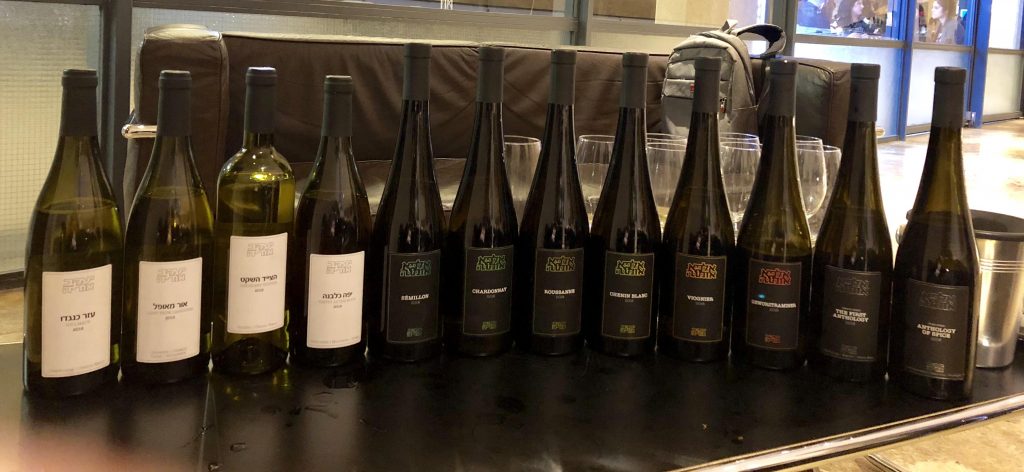 #375 – May 3, 2019
#375 – May 3, 2019
This page discusses a very special winemaker of incredible depth, talent and modesty, who I am tremendously happy to see finally getting his due. Ever since Yaacov Oryah’s story graced these pages three years ago, his popularity has risen so dramatically as to render the “one of Israel’s best kept secrets” moniker moot. Given the dramatic increase both in Yaacov’s popularity and the number of new readers since that newsletter was published, I am including an updated version of the man’s history before getting into his current focus, wines and plans for the future. For those familiar with the background, feel free to skip the next few paragraphs.
Know Thy History
Given how well I know Yaacov and his wines, it’s crazy to think that I didn’t meet Yaacov in person until January 2014, during the Sommelier Expo in Tel Aviv. However, I have been tasting (and recommending) his wines for year’s prior, ever since 2010 when someone sent me a bottle of Asif Winery’s 2009 Chavlei Aretz Avant Garde, which was the same bottle that led me to delve deeper into the man behind the delicious wine. The oddly-worded kashrut information on the bottle’s label piqued my curiosity and ultimately led me to an article from 2006 in the Israeli culinary magazine “Wine and Gourmet” penned by Asif’s Orthodox winemaker (Yaacov), which called into question much of the practical halacha relating to the kashrut of wine. In the same vein as Yaacov’s winemaking and overall philosophy of life, he was ahead of his times with views. While these days his opinions are much more widely disseminated (in part due to the two in-depth and highly recommended books on the topic by Dr. Hayim Soloveitchik), they remain outside of mainstream accepted halachik practice.
Yaacov was born in New York and made Aliyah with his charedi parents at the tender age of five where his family settled in Bnei Brak. From a relatively early age his interests diverged somewhat from the mainstream charedi community he belonged to, joining Bnei Akiva as a teen-ager and fully breaking from tradition by studying in Yeshiva HaKotel under the auspices of the hesder program. Despite being the first member of his extended family to serve in the army, following his service Yaacov returned to the fold, got married, had children and, after spending some additional time learning in various yeshivot, started working in construction while studying toward an engineering degree.
While wine was always of interest to him, his relationship with it was primarily as an enthusiastic imbiber until 2003 when he discovered that Sorek Winery was offering entry-level winemaking classes. Taking his first course in 2004 and leasing his first vineyard the year after, Yaacov quickly realized that his interest was far deeper than he had imagined. In 2006, together with a partner, he founded Asif Winery, initially intending it to be a form of négociant, only to realize that this traditional French method of doing business in the wine industry was ill suited to the Israeli business climate where procuring raw materials of sufficient quality was far more difficult than he had imagined. It was at this point that Yaacov recognized his inner desire to create wine on his own and, with Itai Lahat at his side as an advisor; Asif released its first vintage of approximately 15,000 bottles for the 2007 vintage. Over the years production increased to about 20,000 bottles by the 2010 vintage in addition to another 10,000 bottles or so made for private clients under the auspices of the custom crush facility (which ironically was created to provide kosher crush facilities for winemakers that couldn’t obtain kosher supervision).
Religious Rumblings
With economic realities dictating the winery’s move in 2008 from Moshav Bnei Atarot to the southern city of Arad, the winery’s focus on true local desert terroir wines became another focus point for the winery. It was at this time that the winery’s economic difficulties started. When located in Atarot, the winery’s hashgacha was under the local rabbanut, which enabled them to sell their wines to the kosher-observing public, which comprise the bulk of Israel’s wine consumer market. However, the rabbanut’s office located in Arad had a rather negative view of Yaacov’s anti-establishment posture reflected in his aforementioned article and denied the fledgling winery a formal hashgacha. By doing so, the rabbanut imperiled not only the winery’s sales but also its potential competitive advantage as a kosher custom crush winery, combining to eliminate much of its anticipated revenue. All this despite the fact that that many kashrut-keeping Jews who knew [and trusted] Yaacov happily drank his wines irrespective of his lacking a formal hashgacha. This somewhat ludicrous situation was the catalyst for the aforementioned language on Asif’s bottles that stated that the wine was prepared in accordance with all applicable halachot and only by Jews.
With his life choices already clearly establishing him as a maverick, it shouldn’t have surprised anyone that his wines showcased the same independent tendencies, with Asif focusing primarily on white wines. With rare clarity of vision, right off the bat Yaacov realized how appropriate white wines were for Israel’s Mediterranean terroir long before it became our current mainstream thinking. From his first days as a winemaker Yaacov has always focused his efforts on creating wines that he was intrigued by (and wanted to drink), viewing them as objects of intellectual curiosity in addition to a pleasure-inducing beverage regardless of their perceived marketability.
Waste Not, Want Not
Ever since his early days learning about the winemaking process, Yaacov struggled with the standard practice of discarding the skins from grapes intended to make white wines immediately following press. Given the high value placed on the tannin, flavor compounds and phenolic attributes contributed by the skins during the red winemaking process, it seemed illogical to discard so much of the grape’s makeup when utilizing it to make white wine. Starting with Asif’s first vintage in 2007, Yaacov was already experimenting with the fermentation of white grape varietals on their skins for periods far longer than the accepted few hours. It wasn’t until he turned out a commercial version of such a wine for the 2010 vintage that he discovered there were others making these types of wines and Orange Wines were an actual wine genre with an illustrious and ancient past (it was Daniel Rogov who informed him of this while tasting the aforementioned wine). In those days Yaacov preferred to describe his wines as “white wines with extended skin maceration” instead of Orange Wines (partially due to their lack of oxidation and the addition of sulfites), he has come around and refers to his current crop of ten(!) 2018 Orange Wines as such (more on that later).
A Maverick in the Making
While much easier to comprehend, another area in which Yaacov was a pioneer early on is the focus on harvesting a percentage of his grapes early on and subsequently blending the juice with later harvested and fully ripened grapes. This is done to combat Israel’s hot weather while providing his wines with the proper balance between phenolic ripeness, flavor compounds and sufficient acidity (I am continuously surprised at winemakers who don’t adapt this practice in some form).
Intellectual and honest wines are always sought after and appreciated by wine geeks and Yaacov rapidly found favor and acceptance among Israel’s wine cognoscenti. His wines rapidly infiltrated the wine list of Israel’s top [non-kosher] restaurants, while his white wines achieved near-cult status (and represented nearly 100% of Asif’s production from the 2009 vintage). However, the lack of mainstream appeal (and extensive oak aging) that us wine geeks find so attractive in our wines is exactly the opposite of what any winery needs in order to be commercially successful and intellectual curiosity and philosophical winemaking rarely translates into financial success. The young winery rapidly found itself on unstable economic terms, leading it to search for a white knight financial backer who re-branded as Midbar after the desert terroir so crucial to the identity of its wines. Unfortunately the new owners and Yaacov didn’t exactly see eye-to-eye on a number of fronts and Yaacov found himself looking for a new gig that would hopefully allow him at least a certain level of creative freedom.
A Harmonious Marriage
As he searched for a replacement mainstream gig, Yaacov’s personal winemaking continued unabated, with some of those creations reviewed below. Starting in 2014 Yaacov assumed the position of Psagot’s chief winemaker and immediately started to make an impression, especially (and unsurprisingly) with respect to Psagot’s white wines. Despite Psagot being a large commercial winery, Yaacov has achieved a great middle ground between the requirement to produce commercially viable wines while imprinting his winemaking style and helping to further elevate Psagot’s overall quality winemaking. Additionally, with an arrangement similar to other winemakers at large commercial wineries, Yaacov is able to continue his intellectual winemaking under his own label and for others. Examples of the numerous other winemakers with similar arrangements include Ido Lewinsohn (Barkan/Lewinsohn), Kobi Arbiv (Recanati/Mia Luce), Jonathan Hajdu (Covenant/Hajdu) and Pierre Miodownick (Netofa/Nadiv/Bordeaux).
In addition to Psagot and his own wines discussed below, Yaacov spent a brief stint at Ella Valley Vineyards following the departure of Lin Gold (after filling in for her during her maternity leave), but that stint was extremely short-lived with a negligible long-term impact on that struggling winery and acts a consultant to a number of winemakers in a variety of ways (including Amos and Zwebner). However, as Yaacov grows production to meet his rising popularity he is cutting down on many of these consulting gigs in order to focus on a cohesive strategy for his brand.
What’s in a Name
Over the years Yaacov has produced a potpourri of wines including an annual red wine blend for the Claro (and now Brut) restaurants, a highly unique varietal Sémillon from 2009 (Valley of the Hunters after the Australian Hunter Valley style Yaacov utilized), two “Rioja-styled” wines (Iberian Dream), a delightful GSM (Grenache, Syrah and Mourvèdre) and one of most interesting (and delicious) kosher dessert wines I have ever tasted – the Old Musketeer. His playful, creative and intellectual curiosity isn’t limited to Yaacov’s winemaking philosophy but carry over to the name of each wine he turns out. As you will see from the list below (and the explanations in the TNs), each wine had a hidden meaning or play on words reflecting something about the wine or its production.
Starting with the 2014 vintage, Yaacov started a rebranding effort, consolidating his wines under the current eponymous label, housing his entire (growing) portfolio of wines and creating the Alpha Omega label, which now represents his entire line of Orange-styled wines. The Greek equivalent of “from A to Z,” the name refers to Yaacov’s view that this style of winemaking yields the purest and most complete expression of the grape variety while also reflecting the utilization of the entire piece of fruit. Over the years Yaacov has produced a large number of wines, with the ones produced under his own name / label listed in their entirety below. As you can see, he has significantly ramped up production starting with the 2017 vintage, partially to meet increasing demand for his precise, elegant and intellectually stimulating wines. Don’t worry – they are deliciously enjoyable as well!
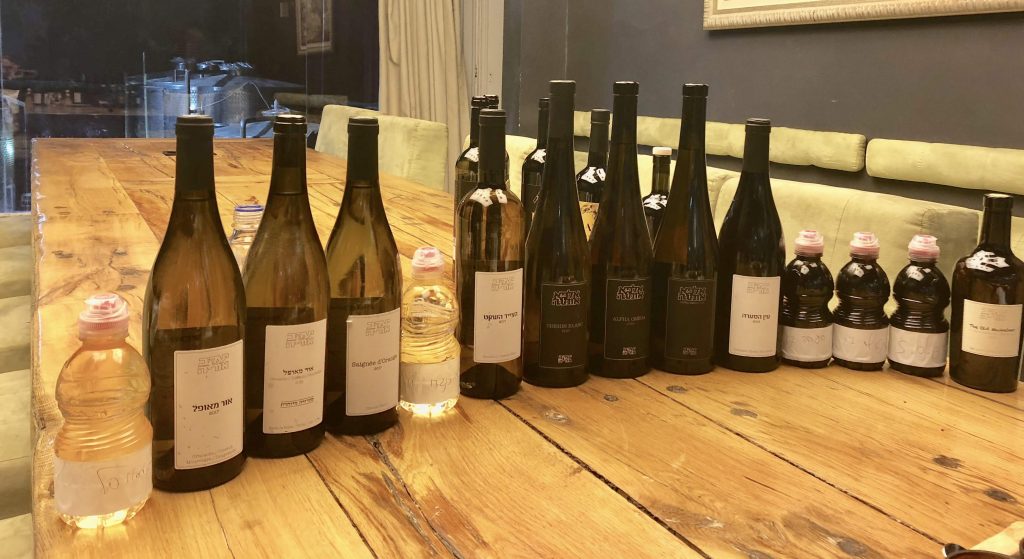
| 2008 Old Musketeer2009 Valley of the Hunters2011 Iberian Dream Reserva (Rioja-styled wine) Iberian Dream Gran Reserva (Rioja-styled wine)2013 Claro (exclusive red blend for Claro)2014 Alpha Omega (Orange-styled blend) Claro Eye of the Storm Pandora’s Riddle (exclusive red blend for Brut)2015 Alpha Omega Claro Eye of the Storm Jemma (exclusive orange wine for Brut)2016 Alpha Omega Eye of the Storm Jemma Light from Darkness Pandora’s Riddle Timrot Ashan (exclusive red blend for Brut)
|
2017 2018 Alpha Omega Varietals: Chardonnay, Chenin Blanc, Gewürztraminer, Semillon, Roussanne, Viognier |
Word to the Wise
Wine geeks are always on the lookout for new and interesting things, which is one of the many reasons Yaacov’s wines rapidly gained favor and near-cult status among Israel’s wine-drinking elite (precise winemaking, meticulous care, creativity and obvious talent played a big part here as well). However, other than a few wines, they aren’t mainstream wines and can be difficult to appreciate, especially for those weaned on fruit-forward, big, bold and alcoholic wines with plenty of oak. Given his desire to allow the fruit to lead the way and a propensity to harvest early, maintain acidity and use oak only as and when required, many of the wines can be confusing to comprehend, getting in the way of a wine’s primary purpose – to provide pleasure. Even those who have turned the corner and love refreshing and crisp whites won’t find what they are looking for in Orange wines, whose funkiness and subdued flavors provide contra to the acidity and prevent it from screaming across your palate (it’s there in spades and necessary to balance the heft). Other than Yaacov’s multiple Orange-styled creations, the kosher wine world still has limited options with only a few other options including offerings from Bat Shlomo, Hajdu and Herzog.
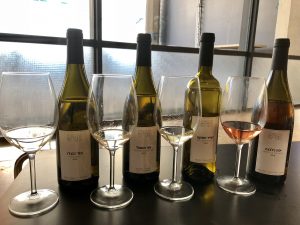 Interestingly, those not yet into wines can find orange-styled wines enjoyable as they are neither heavily tannic like many newly-released red wines or overly astringent like so many of today’s white wines while providing subdued honeyed fruit notes with sour undertones. From Yaacov’s perspective, the wines are there to stimulate thought, conversation and wonderment while also providing pleasure. For the most part, the wines range between 11% – 13% AbV, a rarity for Israeli wines and nearly all of them benefit from time and quiet contemplation. This doesn’t mean they don’t provide immense pleasure as enjoyable wines, but rather they are intellectual wines with a whole additional side of contemplation waiting to be discovered. Either way, all the wines are highly recommended and, like most other wines, will be much more enjoyable with a few friends while tasting a number of them side by side and comparing notes.
Interestingly, those not yet into wines can find orange-styled wines enjoyable as they are neither heavily tannic like many newly-released red wines or overly astringent like so many of today’s white wines while providing subdued honeyed fruit notes with sour undertones. From Yaacov’s perspective, the wines are there to stimulate thought, conversation and wonderment while also providing pleasure. For the most part, the wines range between 11% – 13% AbV, a rarity for Israeli wines and nearly all of them benefit from time and quiet contemplation. This doesn’t mean they don’t provide immense pleasure as enjoyable wines, but rather they are intellectual wines with a whole additional side of contemplation waiting to be discovered. Either way, all the wines are highly recommended and, like most other wines, will be much more enjoyable with a few friends while tasting a number of them side by side and comparing notes.
Personally, tasting through ten Orange wines from one vintage across multiple varietals (and even winemaking styles) was fascinating and doing so together with Yaacov increased my pleasure, enjoyment and the educational aspect of the tasting tenfold. Given Yaacov’s goal of expressing the complete essence of the varietal it would have been really cool to taste the same varietal wine in both Orange-style and as a straight wine, but 40 wines would likely have been too much for him, especially given his duties as Psagot’s chief winemaker (food for thought Yaacov).
Fresh off the Boat
After years of reigning supreme on the “Israel Only” list, a number of Yaacov’s wines are being imported into the US by Liquid Kosher and should be available soon directly from the importer. Otherwise, all of the wines are available in Israel directly from Yaacov (Yaacov.oryah@gmail.com). As I hope has been conveyed through this newsletter (and the tasting notes below) – all are highly recommended (with respect to the Alpha Omega wines, subject to how your palate feels about the style) and are available in relatively limited quantities.
The Man behind the Mission
Each of his wines speaks for themselves as a stand-alone masterpiece of precision and creative winemaking. However, despite all the ink poured until now, one would walk away missing a significant part of the picture if I wasn’t to briefly say a few words about the individual behind the wines. Easily one of the most understated personalities in the Israeli wine world, Yaacov projects a quiet contemplation that belies an immense intellectual curiosity that knows no bounds. Powerfully charismatic, Yaacov is a lover of men and strongly believes in engaging with people from all walks of life, while striving to focus on that which unites us instead of what divides us. His intellectual curiosity, powerful charisma and tremendous humility make him one of the most enjoyable people with whom to spend time. I always feel that I’d rather be talking about ten different things in addition to the wine-related topics we inevitably gravitate towards. He is a true renaissance man and despite knowledge across a wide-ranging array of topics, he is always thinking, exploring and striving to do more, making his a great person to hang out with, talk to and learn from. The dualities of making wine for the general public at Psagot while creating contemplative and serious wines that demand your attention under his eponymous label are only reconcilable in an individual as unique as he is. As such, this newsletter represents a rare instance where knowing a bit about the man is a pre-requisite to enjoying and understanding the wines. I highly recommend taking the time to seek him out, taste his wines and spend some time with Yaacov Oryah. I have and continue to learn much from him and hope your encounters with Yaacov and his wines will lead you to appreciate his talents as much as I do!
Shabbat Shalom,
Yossie
2018
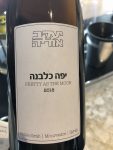 Yaacov Oryah, Pretty as the Moon (Yafa K’Levana), Rosé, 2018: Have no fear – being one of the least likely winemakers to follow any sort of trend, Yaacov hasn’t succumbed to the prevailing winds of rose – the wine is a mistake of sorts, as ever-so-subtlety indicated by the play on words in the wine’s name. A blend of Petite Sirah (53%), Mourvèdre (29%) and Syrah (18%) that was intended to be a blanc de noir but turned out as a rose de noir instead. Levana is Hebrew for the moon and the female form of the color white, reflecting the fact that the wine is a great as the white wine it was intended to be. The wine has a subtle nose of dark red fruit including tart raspberries and pomegranate along with some funky minerals, slate and heather notes. The medium bodied palate is loaded with bright acidity that is nicely balanced with the slightly hefty fruit, more minerals and a streak of slightly bitter salinity that carries through the lingering finish. A delicious and easy to drink wine with enough complexity to please the more discerning wine lovers as well. 13% AbV. Drink now and over the next 9-15 months or so.
Yaacov Oryah, Pretty as the Moon (Yafa K’Levana), Rosé, 2018: Have no fear – being one of the least likely winemakers to follow any sort of trend, Yaacov hasn’t succumbed to the prevailing winds of rose – the wine is a mistake of sorts, as ever-so-subtlety indicated by the play on words in the wine’s name. A blend of Petite Sirah (53%), Mourvèdre (29%) and Syrah (18%) that was intended to be a blanc de noir but turned out as a rose de noir instead. Levana is Hebrew for the moon and the female form of the color white, reflecting the fact that the wine is a great as the white wine it was intended to be. The wine has a subtle nose of dark red fruit including tart raspberries and pomegranate along with some funky minerals, slate and heather notes. The medium bodied palate is loaded with bright acidity that is nicely balanced with the slightly hefty fruit, more minerals and a streak of slightly bitter salinity that carries through the lingering finish. A delicious and easy to drink wine with enough complexity to please the more discerning wine lovers as well. 13% AbV. Drink now and over the next 9-15 months or so.
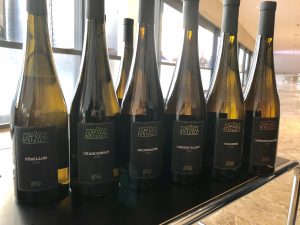
Yaacov Oryah, Alpha Omega, Chardonnay, 2018: 100% unoaked Chardonnay which spent 2.5 weeks macerating on its skins. Like many orange-styled wines, the nose is on the subtle side with lovely green apples, warm spices and herbal notes along with plenty of flinty minerals, much of which is present on the medium bodied palate that needs some air to open up. Floral notes and jasmine combine with the tart green apples, quince and more minerals with good balancing acidity keeping things honest. Great balance reflects Yaacov’s precise winemaking skills. 13% AbV. Drink now through 2023.
Yaacov Oryah, Alpha Omega, Chenin Blanc, 2018: Together with Sémillon, Chenin Blanc seems to be the wine with which Yaacov creates the most powerful magic and is also the best suited for the Orange-treatment. A beautiful nose redolent with fresh and vibrant sweet apple, pear and some floral notes that overwhelm initially but settle down nicely with a bit of air (a prerequisite for nearly all the Orange-styled wines I have tasted) and play nicely with the fruit which is enhanced by lovely flinty minerals, hints of smoke, heather and lovely citrus nose together with the characteristic oxidized funkiness that adds pleasing complexity and character. The medium bodied palate has loads more fruit which is tamed by rich mineral notes, more smoke and sweet herbs, with floral notes leading the way to the lingering finish. Drink now (with 30-45 minutes of air) through 2024.
Yaacov Oryah, Alpha Omega, Gewürztraminer, 2018: 100% Gewürztraminer sourced from the same vineyard as the Chardonnay above, the wine spent 2.5 weeks macerating on its skins and presents in a pale pink salmon color derived from the unique color hue of the grape’s skins. Characteristic of the grape, the nose is highly aromatic with plenty of lavender, rose hips, floral notes, tropical fruit and orange citrus notes along with the typical lychee notes, plenty of warm spice and a hint of smoke. The medium bodied palate is still tight but with air reveals loads more spice and tropical fruits including pineapple, more sweet citrus and slate minerals together with a subtle bitter herbal streak that adds complexity. Supremely well balanced with great acid backing it up, over time the abundant floral notes fade to reveal more traditional Gewurz notes. Drink now (with 30 minutes of air) through 2022, maybe longer.
Yaacov Oryah, Alpha Omega, Roussanne, 2018: Like most of Yaacov’s 2018 Orange-styled wines, at this stage the wine is closed and tight, requiring some air time to reveal the secrets beneath. Pears, heather, honeysuckle, warm spices and citrus notes dominate the nose together with flinty minerals. The medium bodied palate showcases far more tannin and power than the Chardonnay and Sémillon. The wine is lean, subtle, and austere with incredible balance between the great acidity, deep fruit and complexity granted by the minerals and smoky overlay. Really a lovely wine whose development I am excited to follow over the years. If this is the “essence” of Roussanne, sign me up! Drink now through 2023, likely longer.
Yaacov Oryah, Alpha Omega, Sémillon, 2018: Reflecting the vineyard’s quality and Yaacov’s expertise with (and love for) the grape, this is one of my favorite Orange wines yet. An expansive nose is loaded with funky oxidized nose backing up tart green apples, lemon and orange citrus, slate minerals, brown spices and honeyed notes. The medium bodied palate is slightly oily and viscous and needs plenty of air to open up but once it does you are rewarded with honeyed fruit kept in check with good acidity, elegant tannins, more citrus and minerals. Delicious now, complexity will come with age so give this one the time is deserves and wait at least 12 months before opening and then enjoy through 2026, likely longer.
Yaacov Oryah, Alpha Omega, Viognier, 2018: Sourced from a Northern vineyard located near Har Tavor, the wine showcases the traditional Viognier characteristics and presents as a delicious, approachable, round and mouth-filling wine with lovely peach, apricot and other tropical fruits joined by floral notes, warm spices and backed by great acidity. The medium bodied palate is still closed but really opened up as the wine warmed in the glass and after 45 minutes layers of complex flavors were revealed including roasted hazelnuts, smoky oak, brown spices and flinty minerals; while the wine remained a delightful simple pleasure to drink. Drink now through 2021, maybe longer.
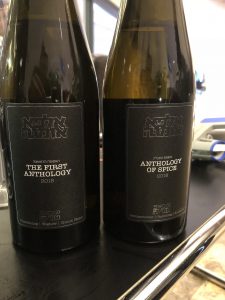 Yaacov Oryah, Alpha Omega, The First Anthology (HaAsufa HaRishona), 2018: As alluded to by the name, the wine pays homage to Yaacov’s first Orange wine – the 2007 Asif mentioned above (Asufa and Asif share the same root in Hebrew). Utilizing the same varietals as that initial blend – Chardonnay, Viognier and Chenin Blanc (albeit in different percentages – 40%, 40% and 20% respectively), the components are comprised of the varietal Alpha Omega Orange-styled wines listed above. A subdued nose has plenty of yellow sweet apple and pears along with warm spice. The medium bodied palate has plenty of sweet fruit, baked apple pie, flinty minerals on a background of cloves and more minerals and backed by good acidity, elegant subtle tannins and sweet herbs. powerful and elegant, the wine is lithe and precise with citrus and earthy notes lingering long. Drink now through 2023.
Yaacov Oryah, Alpha Omega, The First Anthology (HaAsufa HaRishona), 2018: As alluded to by the name, the wine pays homage to Yaacov’s first Orange wine – the 2007 Asif mentioned above (Asufa and Asif share the same root in Hebrew). Utilizing the same varietals as that initial blend – Chardonnay, Viognier and Chenin Blanc (albeit in different percentages – 40%, 40% and 20% respectively), the components are comprised of the varietal Alpha Omega Orange-styled wines listed above. A subdued nose has plenty of yellow sweet apple and pears along with warm spice. The medium bodied palate has plenty of sweet fruit, baked apple pie, flinty minerals on a background of cloves and more minerals and backed by good acidity, elegant subtle tannins and sweet herbs. powerful and elegant, the wine is lithe and precise with citrus and earthy notes lingering long. Drink now through 2023.
Yaacov Oryah, Alpha Omega, Anthology of Spice (Asofat HaTavlin), 2018: A blend of Gewurztraminer (50%), Chardonnay (40%) and Roussanne (10%) but, unlike the First Anthology, here the Gewurztraminer is not the same one used in the Alpha Omega above but rather a different, wildly aromatic version (also made Orange-style and then blended with the other components. Sweet and extremely well made with Yaacov’s characteristic precise winemaking, with the spicy Gewürztraminer notes dominating. The expressive nose needs some air to open up but then you are rewarded with heady floral notes, rose hips and awesome spice, all grounded by the Orange-oxidized funk, minerals and a subtle smoky note that adds complexity. The medium to full-bodied palate has nicely integrated tannins and a good acidic core providing backbone to the heady spice and floral notes. Gun smoke, flint and some sweet fruit linger long. Give this one the time is needs and deserves, whether opening now or waiting 12 months before enjoying through 2026.
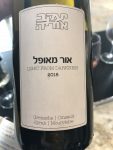 Ya’acov Oryah, Light from Darkness (Or M’Ofel), 2018: A blend of 33% Grenache, 31% Cinsault, 24% Syrah, and 12% Mourvèdre, the wine’s name basically means blanc de noir (Light (wine) from Darkness (grapes)). The wine was made with no skin contact or malolactic fermentation, which allowed for a fresh and vibrant wine. Harvested early, the wine clocks in at 11.5% AbV. Plenty of red fruit and floral notes on both the nose and palate along with rich minerals, near-sweet tropical fruit with plenty of lip-smacking acidity. With air, the wine opens up to reveal layers of complexity along with freshly dried hay and herbal notes. Drink now through 2021.
Ya’acov Oryah, Light from Darkness (Or M’Ofel), 2018: A blend of 33% Grenache, 31% Cinsault, 24% Syrah, and 12% Mourvèdre, the wine’s name basically means blanc de noir (Light (wine) from Darkness (grapes)). The wine was made with no skin contact or malolactic fermentation, which allowed for a fresh and vibrant wine. Harvested early, the wine clocks in at 11.5% AbV. Plenty of red fruit and floral notes on both the nose and palate along with rich minerals, near-sweet tropical fruit with plenty of lip-smacking acidity. With air, the wine opens up to reveal layers of complexity along with freshly dried hay and herbal notes. Drink now through 2021.
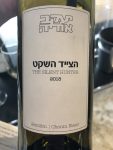 Ya’acov Oryah, Silent Hunter (HaTzayad HaShaket), 2018: The wine’s name alludes to Australia’s Hunter Valley – home to some of the longest-lasting (and most interesting) expressions of Semillon out there, with the silence referring to the Chenin’s dominance in the blend (despite the lower percentage). A blend of Semillon (60%) and Chenin Blanc (40%), the Chenin adds significant heft (and some floral perfume) without taking away from the heather and mineral notes the Semillon brings to the table. The expressive nose is clean, precise and elegant with near-sweet fruit balanced with saline minerals, gun smoke, flint and creamy citrus notes. The medium bodied palate is loaded with acid that provides perfect contra to the rich fruit, slate minerals and lip-smacking citrus that evolves throughout the long mid-palate into the long lingering finish. I enjoyed this wine’s evolution over seven hours and it wasn’t close to being done. Highly enjoyable now but with so much hidden potential ahead of it, it’s almost criminal to open it now, but if you must make sure it gets at least two hours in the decanter. Better to wait 12-18 months before enjoying through 2025, maybe longer. 11.5% AbV.
Ya’acov Oryah, Silent Hunter (HaTzayad HaShaket), 2018: The wine’s name alludes to Australia’s Hunter Valley – home to some of the longest-lasting (and most interesting) expressions of Semillon out there, with the silence referring to the Chenin’s dominance in the blend (despite the lower percentage). A blend of Semillon (60%) and Chenin Blanc (40%), the Chenin adds significant heft (and some floral perfume) without taking away from the heather and mineral notes the Semillon brings to the table. The expressive nose is clean, precise and elegant with near-sweet fruit balanced with saline minerals, gun smoke, flint and creamy citrus notes. The medium bodied palate is loaded with acid that provides perfect contra to the rich fruit, slate minerals and lip-smacking citrus that evolves throughout the long mid-palate into the long lingering finish. I enjoyed this wine’s evolution over seven hours and it wasn’t close to being done. Highly enjoyable now but with so much hidden potential ahead of it, it’s almost criminal to open it now, but if you must make sure it gets at least two hours in the decanter. Better to wait 12-18 months before enjoying through 2025, maybe longer. 11.5% AbV.
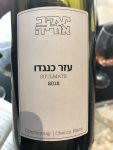 Ya’acov Oryah, Soulmate (Ezer K’Negdo), 2018: the wine’s name has a dual meaning, reflecting how the perfect mate creates a sum greater than its part but also pays homage to Yaacov’s wife Patricia who convinced him to use the varietal in the blend, which resulted in this delightfully delicious wine. A blend of Chardonnay (55%) and Chenin Blanc (45%), the Chardonnay is sourced from a plot shared with Domaine du Castel and Vitkin. Great viscosity, medium bodied with hints of tropical fruit with plenty of clean minerals and warm spices galore. Fresh and vibrant with clean lines and hefty fruit from the Chardonnay. Red grapefruit, Mayer lemon and plenty of floral notes provide the over-arching notes with the minerals and acid providing the underlying background that carries the wine through. Lithe and delicious, the wine is highly enjoyable. 12.5% AbV. Drink now through 2021.
Ya’acov Oryah, Soulmate (Ezer K’Negdo), 2018: the wine’s name has a dual meaning, reflecting how the perfect mate creates a sum greater than its part but also pays homage to Yaacov’s wife Patricia who convinced him to use the varietal in the blend, which resulted in this delightfully delicious wine. A blend of Chardonnay (55%) and Chenin Blanc (45%), the Chardonnay is sourced from a plot shared with Domaine du Castel and Vitkin. Great viscosity, medium bodied with hints of tropical fruit with plenty of clean minerals and warm spices galore. Fresh and vibrant with clean lines and hefty fruit from the Chardonnay. Red grapefruit, Mayer lemon and plenty of floral notes provide the over-arching notes with the minerals and acid providing the underlying background that carries the wine through. Lithe and delicious, the wine is highly enjoyable. 12.5% AbV. Drink now through 2021.
2017
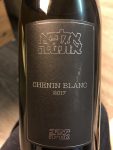 Yaacov Oryah, Alpha Omega, Chenin Blanc, 2017: The wine opens with a near-sweet and expressive nose of heather honeysuckle dominating but also sweet orange citrus notes, pineapple and some yellow pears. The rich nose leads your expectations toward a full and juicy near-sweet wine before the medium bodied and slightly viscous wine hits your palate. There is a complete dissonance between what the nose led you to expect and the lean, subtle and complex palate your mouth experiences – crazy experience. That said, ignoring the false expectations from the nose, the wine is round and mouth-filling with great balancing acidity and subtle fruit augmented by rich flint minerals, saline tannin, roasted nuts, black tea and bitter orange pith. Medium to full bodied with a nice heft and nuanced complexity on clean lines and superb balance. Varietal characteristics of the Chenin are more evident after 30 minutes of air and are pronounced on the mid palate and lingering finish. 11.5% AbV, drink now through 2023.
Yaacov Oryah, Alpha Omega, Chenin Blanc, 2017: The wine opens with a near-sweet and expressive nose of heather honeysuckle dominating but also sweet orange citrus notes, pineapple and some yellow pears. The rich nose leads your expectations toward a full and juicy near-sweet wine before the medium bodied and slightly viscous wine hits your palate. There is a complete dissonance between what the nose led you to expect and the lean, subtle and complex palate your mouth experiences – crazy experience. That said, ignoring the false expectations from the nose, the wine is round and mouth-filling with great balancing acidity and subtle fruit augmented by rich flint minerals, saline tannin, roasted nuts, black tea and bitter orange pith. Medium to full bodied with a nice heft and nuanced complexity on clean lines and superb balance. Varietal characteristics of the Chenin are more evident after 30 minutes of air and are pronounced on the mid palate and lingering finish. 11.5% AbV, drink now through 2023.
Yaacov Oryah, Eye of the Storm (Ein HaSa’ara), 2017 [Advance Tasting]: The wine’s name is a nod toward to storm that was Yaacov’s personal life for some time with grapes, the vineyard and winemaking keeping him grounded. Very similar to the 2016 version below, the wine is a blend of Syrah (42%), Grenache (36%), Mourvèdre (11%) and Cinsault (11%). However the 2017 saw a small percentage of new oak during the 12 month barrel-aging process and showcases darker fruit that, even though seems riper is more controlled with the wine presenting clean lines, tight structure and well balanced between the rich dark red fruit, good acidity and near-elegant tannins. Red plums, sour cherries and some currents are augmented with fresh-paved road, graphite and roasted meat, combined with an herbal underlay and backed by savory and gripping tannins. Drink now through 2023.
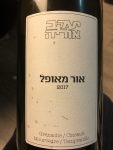 Ya’acov Oryah, Light from Darkness (Or M’Ofel), 2017: In addition to the Grenache Noir, Cinsault, Syrah, and Mourvèdre included in the 2018 blend above, this wine included Tempranillo as well. The wine’s name is basically Hebrew for blanc de noir (Light (wine) from Darkness (grapes)). More fruit forward and approachable than the 2016 below, the wine has lovely notes of tropical fruit, melon and citrus with less red fruit. A highly aromatic nose and medium bodied palate are both loaded to bear with citrus galore, slate minerals and some stone summer fruits all backed with judicious acid impeccably balanced with the rich and slightly viscous fruit and hefty dose of minerals. 11%AbV. Drink now through 2022.
Ya’acov Oryah, Light from Darkness (Or M’Ofel), 2017: In addition to the Grenache Noir, Cinsault, Syrah, and Mourvèdre included in the 2018 blend above, this wine included Tempranillo as well. The wine’s name is basically Hebrew for blanc de noir (Light (wine) from Darkness (grapes)). More fruit forward and approachable than the 2016 below, the wine has lovely notes of tropical fruit, melon and citrus with less red fruit. A highly aromatic nose and medium bodied palate are both loaded to bear with citrus galore, slate minerals and some stone summer fruits all backed with judicious acid impeccably balanced with the rich and slightly viscous fruit and hefty dose of minerals. 11%AbV. Drink now through 2022.
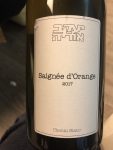 Yaacov Oryah, Saignée d’Orange, 2017: Bled from the Alpha Omega Chenin Blanc above, the wine is 100% Chenin Blanc. When bleeding the juice of red grapes, the result is a Rose while bleeding the juice of a white grape yielded a wine that tastes like an orange wine while presenting like a white one. Pronounced funk and the subtle viscosity of Yaacov’s orange wines, the wine showcases floral and mineral notes with the fruit subdued in the background. Nicely balancing acidity and spicy ginger notes round out the wine and give it some welcome complexity. 11.5% AbV. Drink now.
Yaacov Oryah, Saignée d’Orange, 2017: Bled from the Alpha Omega Chenin Blanc above, the wine is 100% Chenin Blanc. When bleeding the juice of red grapes, the result is a Rose while bleeding the juice of a white grape yielded a wine that tastes like an orange wine while presenting like a white one. Pronounced funk and the subtle viscosity of Yaacov’s orange wines, the wine showcases floral and mineral notes with the fruit subdued in the background. Nicely balancing acidity and spicy ginger notes round out the wine and give it some welcome complexity. 11.5% AbV. Drink now.
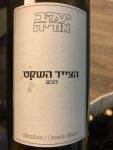 Ya’acov Oryah, Silent Hunter (HaTzayad HaShaket), 2017: The wine is an unoaked blend of 60% Sémillon and 40% Chenin Blanc (the two varietals that Ya’acov does best with) and the name is a nod to Australia’s Hunter Valley whose Sémillon wines have extensive aging abilities (Yaacov’s 2009 “Valley of the Hunters” was made in that style, as is his not-yet-released 2017 version). The wine was allowed to go through full malolactic fermentation that yielded a rich and unctuous wine, with plenty of delicious fruit kept in check by great tempering acidity. Loads of flinty minerals are accompanied by subtle tropical fruit, dried summer stone fruit, heather and honeysuckle, along with some spice, pear and ginger. Lemon zest and more citrus are enhance by pleasing notes of white flowers, lemongrass, all well-balanced by bracing acidity that ensures this rich and lovely wine stays crisp, vibrant and refreshing all the way through the medium bodied palate to the long lingering and citrus-laden finish. Really a complex wine that is worth your time and patience to open up in the glass. Part of the wine was also made into a sparkling wine, so stay tuned for some exciting sparklers coming from Ya’acov in a few years. At 11% AbV, the wine is great all day, every day and while it can be enjoyed mindlessly, denying the wine some thoughtful contemplation would be missing out on a huge part of the experience. While enjoyable now, the wine has tons of evolution ahead of it, so I’d suggest cellaring a few of your bottles to enjoy over the years through 2028, likely longer.
Ya’acov Oryah, Silent Hunter (HaTzayad HaShaket), 2017: The wine is an unoaked blend of 60% Sémillon and 40% Chenin Blanc (the two varietals that Ya’acov does best with) and the name is a nod to Australia’s Hunter Valley whose Sémillon wines have extensive aging abilities (Yaacov’s 2009 “Valley of the Hunters” was made in that style, as is his not-yet-released 2017 version). The wine was allowed to go through full malolactic fermentation that yielded a rich and unctuous wine, with plenty of delicious fruit kept in check by great tempering acidity. Loads of flinty minerals are accompanied by subtle tropical fruit, dried summer stone fruit, heather and honeysuckle, along with some spice, pear and ginger. Lemon zest and more citrus are enhance by pleasing notes of white flowers, lemongrass, all well-balanced by bracing acidity that ensures this rich and lovely wine stays crisp, vibrant and refreshing all the way through the medium bodied palate to the long lingering and citrus-laden finish. Really a complex wine that is worth your time and patience to open up in the glass. Part of the wine was also made into a sparkling wine, so stay tuned for some exciting sparklers coming from Ya’acov in a few years. At 11% AbV, the wine is great all day, every day and while it can be enjoyed mindlessly, denying the wine some thoughtful contemplation would be missing out on a huge part of the experience. While enjoyable now, the wine has tons of evolution ahead of it, so I’d suggest cellaring a few of your bottles to enjoy over the years through 2028, likely longer.
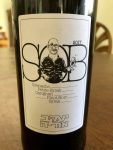 Yaacov Oryah, SOB, 2017 [Advance Tasting]: The wine is a private bottling and Yaacov kept one barrel for himself. An eccentric blend of Grenache (22%), Petite Sirah (21%), Carignan (20%), Pinot Noir (19%) and Syrah (18%), each component was added for a specific purpose. The wine is obviously super young and needs time to come together. At this point there is plenty of ripe red fruit on both the nose and palate alongside toasty oak (the wine was aged in one new 300 liter barrel and two one-year old barrels) and nice earthy minerals. The medium bodied palate is backed by gripping elegant tannins, with good acidity keeping things lively. Fruit forward and fun at this point, I’d give the wine at least a year before opening, after which is should cellar through 2022, likely longer (given the uniqueness of the blend, I am erring on the side of caution here).
Yaacov Oryah, SOB, 2017 [Advance Tasting]: The wine is a private bottling and Yaacov kept one barrel for himself. An eccentric blend of Grenache (22%), Petite Sirah (21%), Carignan (20%), Pinot Noir (19%) and Syrah (18%), each component was added for a specific purpose. The wine is obviously super young and needs time to come together. At this point there is plenty of ripe red fruit on both the nose and palate alongside toasty oak (the wine was aged in one new 300 liter barrel and two one-year old barrels) and nice earthy minerals. The medium bodied palate is backed by gripping elegant tannins, with good acidity keeping things lively. Fruit forward and fun at this point, I’d give the wine at least a year before opening, after which is should cellar through 2022, likely longer (given the uniqueness of the blend, I am erring on the side of caution here).
Yaacov Oryah, The Duke Pontiff, 2017 [Advance Tasting]: Another wine name benefiting Yaacov’s playful curiosity, the Duke refers to the Duchy of Burgundy which is represented by the Pinot Noir in the blend while Pontiff refers to the Châteauneuf-du-Pape appellation, whose style of wine is emulated in this blend of Rhone and Burgundy varietals (Pinot Noir (49%), Syrah (21%), Grenache (18%), Mourvèdre (6%), and Cinsault (6%)). The wine spent 12 months aging as a blend on one year oak and presents with rich ripe red fruit, earthy minerals, some blueberries while the oak dominates more than many of Yaacov’s other wines. Good acidity, gripping tannins give the medium to full bodied wine great structure with tart red fruit, a pleasing bitter herbal underlay joined with rich dark chocolate, freshly cured tobacco leaf and some minty notes on the medium finish. That said, the wine is far from ready and the oak will integrate over the next 12-8 months so make sure to give it the time it deserves and then enjoy through 2022.
2016
Yaacov Oryah, Alpha Omega, 2016: A blend of Roussanne, Semillon, and Viognier which spent three weeks macerating on its skins and 12 months aging in three-year old oak barrels (which were used as new oak for the 2014 Alpha Omega). The rich and somewhat extracted wine has a lovely nose of sweet tropical fruits including guava and pineapple alongside gobs of juicy citrus notes, slate minerals, blooming white flowers, brown spices and some caramel. The medium bodied palate has more rich fruit with plenty of citrus and sweet minerals backed by great acidity and an impeccably balanced structure. Tight and focused with precise fruit and a pleasing roundness to it, the wine is enjoyable now and benefits from about 45 minutes of air and should cellar nicely through 2024.
 Yaacov Oryah, Alpha Omega, Jemma, Brut, 2016: Made exclusively for the Tel-Aviv restaurant Brut (with whom Yaacov has a close relationship) and named for the eatery’s co-founder – Jemma Naveh. An Orange-styled wine made from 100% Semillon, the wine needs hours and hours of air and is enjoyable every step of the way while being educational as well. With a plush medium to full-bodied palate, the wine showcases loads of warm spices, roasted nuts, fresh-turned earth and earthy mineral notes under plenty of funky orange notes, wild mushrooms, smoke, candied almonds, smoky wood, and dried tropical fruit. Spice and dried nuts linger long with brilliant acidity keeping things interesting. Really interesting and enjoyable wine that will pair well with a near-endless array of foods. Drink now through 2021.
Yaacov Oryah, Alpha Omega, Jemma, Brut, 2016: Made exclusively for the Tel-Aviv restaurant Brut (with whom Yaacov has a close relationship) and named for the eatery’s co-founder – Jemma Naveh. An Orange-styled wine made from 100% Semillon, the wine needs hours and hours of air and is enjoyable every step of the way while being educational as well. With a plush medium to full-bodied palate, the wine showcases loads of warm spices, roasted nuts, fresh-turned earth and earthy mineral notes under plenty of funky orange notes, wild mushrooms, smoke, candied almonds, smoky wood, and dried tropical fruit. Spice and dried nuts linger long with brilliant acidity keeping things interesting. Really interesting and enjoyable wine that will pair well with a near-endless array of foods. Drink now through 2021.
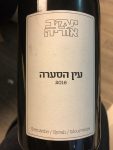 Yaacov Oryah, Eye of the Storm (Ein HaSa’ara), 2016: Yaacov’s GSM has become a regular part of his portfolio and the 2016 is more reminiscent of his delightful 2016 than the 2015 version. The wine spent 12 months in oak given it some pleasing smoky notes in addition to the rich red fruit (which was slightly ripe for me without being sweet), backed by gripping tannins that need time to integrate and good acidity keeping the fruit well balanced while the oak remains in the background. Savory notes of roasted meat, asphalt and leather are joined by earthy minerals, freshly cracked black pepper, earthy minerals and some herbal notes all blend together and yield a food-friendly wine with more mainstream appeal that many of Yaacov’s other wines. 13.5% AbV. Drink now through 2023.
Yaacov Oryah, Eye of the Storm (Ein HaSa’ara), 2016: Yaacov’s GSM has become a regular part of his portfolio and the 2016 is more reminiscent of his delightful 2016 than the 2015 version. The wine spent 12 months in oak given it some pleasing smoky notes in addition to the rich red fruit (which was slightly ripe for me without being sweet), backed by gripping tannins that need time to integrate and good acidity keeping the fruit well balanced while the oak remains in the background. Savory notes of roasted meat, asphalt and leather are joined by earthy minerals, freshly cracked black pepper, earthy minerals and some herbal notes all blend together and yield a food-friendly wine with more mainstream appeal that many of Yaacov’s other wines. 13.5% AbV. Drink now through 2023.
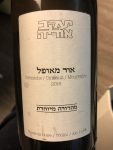 Ya’acov Oryah, Light from Darkness (Or M’Ofel), 2016: Maintaining a reputation for quality experimentation, the wine’s name reflects the creating of a white wine from three Rhône Valley red varietals (Grenache, Cinsault and Mourvèdre), accomplished by not allowing the juice any skin contact whatsoever (all grape juices are clear – the color comes from skin, stems and other parts). As a wine geek I am always excited to taste wines made in a new or interesting manner, many of which aren’t the most delicious of options and I was happy to find this wine didn’t fit into that category – it’s really a yummy wine (in addition to the coolness of having typical red wine notes in a white wine). The nose is redolent with mulberry, raspberry, red cherry along with white flowers, red grapefruit and lime with a hint of bitter green and flinty minerals. The medium to full bodied palate is more robust than you’d expect with great acidity balancing out the rich and deep fruits with plentiful lip-smacking citrus and savory minerals on the mid palate leading into the lingering finish where some bitter grapefruit pith leaves a tantalizing reminder of the delicious treat. 11.5% AbV. Enjoyable now through the middle of 2019.
Ya’acov Oryah, Light from Darkness (Or M’Ofel), 2016: Maintaining a reputation for quality experimentation, the wine’s name reflects the creating of a white wine from three Rhône Valley red varietals (Grenache, Cinsault and Mourvèdre), accomplished by not allowing the juice any skin contact whatsoever (all grape juices are clear – the color comes from skin, stems and other parts). As a wine geek I am always excited to taste wines made in a new or interesting manner, many of which aren’t the most delicious of options and I was happy to find this wine didn’t fit into that category – it’s really a yummy wine (in addition to the coolness of having typical red wine notes in a white wine). The nose is redolent with mulberry, raspberry, red cherry along with white flowers, red grapefruit and lime with a hint of bitter green and flinty minerals. The medium to full bodied palate is more robust than you’d expect with great acidity balancing out the rich and deep fruits with plentiful lip-smacking citrus and savory minerals on the mid palate leading into the lingering finish where some bitter grapefruit pith leaves a tantalizing reminder of the delicious treat. 11.5% AbV. Enjoyable now through the middle of 2019.
2014
 Yaacov Oryah, Alpha Omega, 2014: A limited edition (less than 300 bottles) blend of Roussanne, Viognier and Sémillon that was prepared like an Orange Wine and was allowed to
Yaacov Oryah, Alpha Omega, 2014: A limited edition (less than 300 bottles) blend of Roussanne, Viognier and Sémillon that was prepared like an Orange Wine and was allowed to  macerate on its skins for over two months (73 days) yielding a rich, bold and funky wine that I found to be fascinating but won’t be to everyone’s taste. With his first attempt at Orange wine spending just two weeks on the skins, the Alpha Omega represents a quantum leap forward in this regard. Using the biblical “HaKol Kol Yaacov VeHaYadayim Yedei Eisav” (“the voice is the voice of Yaacov, yet the hands are the hands of Esauv”) wouldn’t be inappropriate in this case. A rich aromatic nose is redolent with rich orange and lemon, honeysuckle, candied citrus peel, scented candles, a whiff of oily petrol, jasmine, lavender and crazily enough – subtle notes of smoked meat. The medium bodied and layered palate has a slightly oily feel to it that is backed up with plenty of acidity that also keeps the rich fruit in check and a completely unnerving tannic structure that can provide whiplash if you aren’t expecting it. Ever more than the 2016, the dissonance between nose and palate can be unnerving. With gun smoke, melon, tart green apple and more juicy citrus alongside oxidized notes, the wine toys with your senses and reveals layers and layers of notes as time passes by. A long and lingering slightly tart and savory finish with an overlay of orange blossom rounds out this incredibly different (and delicious) wine. Made in Yaacov’s house without any formal hashgacha, the wine doesn’t carry any kosher symbols but like his prior wines, he vouches for it, which was enough for me. 13% AbV. Definitely a must try and still needs 1-2 hours in the decanter before it reveals all it has to offer, the wine should continue to evolve through 2021, likely longer.
macerate on its skins for over two months (73 days) yielding a rich, bold and funky wine that I found to be fascinating but won’t be to everyone’s taste. With his first attempt at Orange wine spending just two weeks on the skins, the Alpha Omega represents a quantum leap forward in this regard. Using the biblical “HaKol Kol Yaacov VeHaYadayim Yedei Eisav” (“the voice is the voice of Yaacov, yet the hands are the hands of Esauv”) wouldn’t be inappropriate in this case. A rich aromatic nose is redolent with rich orange and lemon, honeysuckle, candied citrus peel, scented candles, a whiff of oily petrol, jasmine, lavender and crazily enough – subtle notes of smoked meat. The medium bodied and layered palate has a slightly oily feel to it that is backed up with plenty of acidity that also keeps the rich fruit in check and a completely unnerving tannic structure that can provide whiplash if you aren’t expecting it. Ever more than the 2016, the dissonance between nose and palate can be unnerving. With gun smoke, melon, tart green apple and more juicy citrus alongside oxidized notes, the wine toys with your senses and reveals layers and layers of notes as time passes by. A long and lingering slightly tart and savory finish with an overlay of orange blossom rounds out this incredibly different (and delicious) wine. Made in Yaacov’s house without any formal hashgacha, the wine doesn’t carry any kosher symbols but like his prior wines, he vouches for it, which was enough for me. 13% AbV. Definitely a must try and still needs 1-2 hours in the decanter before it reveals all it has to offer, the wine should continue to evolve through 2021, likely longer.
Yaacov Oryah, Eye of the Storm, 2014: A blend of Grenache, Syrah, Mourvedre, petite Sirah, Cinsault and Barbera that somehow really works together, combining for a delicious (and smoky) experience. While enjoyable as a simple beverage, the wine really deserves some quiet contemplation as the layers of complex flavors and nuances are practically outrageous. Give the wine the time and effort it deserves and you will be richly rewarded with loads of rich red forest fruit, hints of boysenberries with loads of floral notes and a backbone of rich saline minerals, roasted meat and grilled bacon. Warm spices, lavender and slightly bitter herbs add plenty of nuance. Black pepper, graphite and some freshly turned earth show up after a while leading into a lingering finish with plenty of warm spices leaving you wanting more. Drink now through 2022.
2011
Yaacov Oryah, Iberian Dream, Reserva, 2011: Named for the Spain’s ancient Aramaic name (Aspania) and using the Talmudic expression for unrealistic dreams, the wine is a blend of Tempranillo, Grenache and Carignan. The only difference between this wine and the Gran Reserva reviewed below is the oak aging. This wine spent 12 months in five-year-old (neutral) oak (while the Gran Reserva spent three years). Still tight with tannins that need some time to integrate, the wine was even more enjoyable the next day. Loaded with rich deep and dark black fruit, earthy minerals, dark bakers chocolate and some notes of smoky oak the full-bodied palate is rich, velvety and caressing. Very much an old world wine made from new world terroir. Darker and more brooding than the Gran Reserva, the wine is finally coming into its own and only requires 2-3 hours at this point in order to be rewarded with great balance and structure along with a voluptuous wine that pampers. Drink now through 2022.
Yaacov Oryah, Iberian Dream, Gran Reserva, 2011: The same wine as the Reserva above that spent three years in oak as opposed to one. The extra time yielded a wine that is far more approachable and polished while retaining a decent aging ability. Rich and near sweet, mostly black fruit on both the nose and medium to full-bodied palate. Nicely integrated yet very powerful tannins hold the rich fruit together in a harmonious blend with the tart cranberry, deep spices, plenty of rich chocolate, pungent forest notes and lovely earthy minerals that are so reminiscent of true Spanish Rioja, it is shocking to think that these are Israeli grapes. Beg Yaacov to sell you a few bottles of this treat but be prepared for rejection, as the quantities are so minuscule as to be non-existent. Drink now through 2021.
2009
Yaacov Oryah, Valley of the Hunters, Semillon, 2009: Intended from the get-go to be released only after a few years, Yaacov harvested these Sémillon grapes extra early. Ultimately the wine was released earlier than intended in minute quantities with Yaacov then [re]acquiring the remaining stock and cellaring it privately until he felt it was ready – a time that has finally arrived. Despite being completely unoaked, the 100% Sémillon wine has some oaky notes. Named after Australia’s Hunter Valley dubbed by Jancis Robinson to be Australia’s greatest gift to the wine world based on the outrageous Sémillon it produces, the wine certainly serves its namesake proud. The wine has a rich and layered nose of tart green apple, white summer fruits, red grapefruit, sweet nectarines, rich Mayer lemons, warm spices and limestone minerals. The medium bodied palate has 11% AbV and plenty more rich fruit, sweet honey, warm spices, saline and more minerals backed up by decent acidity that has lost some of its bite over the last few years. I loved the wine and was happy to have the entire bottle to myself, which allowed me to enjoy its evolution over the many hours it keep, me company. Still vibrant with great acidity, the wine is going strong but is unlikely to evolve further, so I’d drink now (unless you have a lot of bottles, in which case I’d drink one a year until they are gone or start to notably decline).
2008
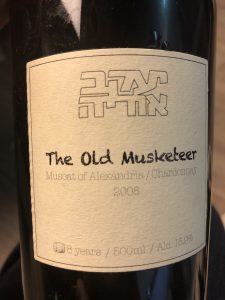 Yaacov Oryah, Old Musketeer, 2008 (8 Year): A limited edition of 1,000 bottles, the wine is late harvested Muscat of Alexandria spent seven years aging in used oak barrels before being blended with 6% 2015 Chardonnay which provided acidity to back up the rich sweetness and balanced out the oxidized notes that give the wine its complexity and testify to its potential longevity. The long-term aging is intended to allow the wine to slowly mature and oxidize providing it with complex flavors while also protecting it from future deterioration due to oxidization, thus prolonging its ageability. Additional wine remains in barrels and Yaacov intends to bottle a barrel or so every year or two (includung the incredible 10-Year option reviewed below). A lively and aromatic nose and a full bodied and rich palate back by good acidity are both redolent of honeysuckle, blooming white flowers, crème brûlée, toasted hazelnuts, white chocolate, candied lemons, a hint of white pepper and expressive notes of tropical fruit all balanced by warm spices and spicy oak and a long lingering sweet finish that is enhanced by great spices and more developing complexity. 15.9% AbV. Drink now through 2035, likely longer
Yaacov Oryah, Old Musketeer, 2008 (8 Year): A limited edition of 1,000 bottles, the wine is late harvested Muscat of Alexandria spent seven years aging in used oak barrels before being blended with 6% 2015 Chardonnay which provided acidity to back up the rich sweetness and balanced out the oxidized notes that give the wine its complexity and testify to its potential longevity. The long-term aging is intended to allow the wine to slowly mature and oxidize providing it with complex flavors while also protecting it from future deterioration due to oxidization, thus prolonging its ageability. Additional wine remains in barrels and Yaacov intends to bottle a barrel or so every year or two (includung the incredible 10-Year option reviewed below). A lively and aromatic nose and a full bodied and rich palate back by good acidity are both redolent of honeysuckle, blooming white flowers, crème brûlée, toasted hazelnuts, white chocolate, candied lemons, a hint of white pepper and expressive notes of tropical fruit all balanced by warm spices and spicy oak and a long lingering sweet finish that is enhanced by great spices and more developing complexity. 15.9% AbV. Drink now through 2035, likely longer
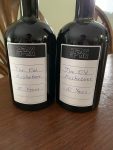 Yaacov Oryah, Old[er] Musketeer, 2008 (10 Year): As mentioned above, Yaacov initially bottled two of the ten barrels he made of this incredible wine. In honor of the very special dinner we both attended prior to KFWE London, Yaacov acquiesced to my request and brought with him a barrel sample of the wine having aged for two additional years in the barrel. Following the incredible showing of the wine, Yaacov has decided to do a commercial barreling of the wine representing the ten-year, with subsequent bottling following once a year or every two years. As incredible as the 8-Year is, the 10-Year was so much better it was unbelievable, showcasing the incredible impact oxidization can have on a wine when used properly. There was less maple sugar and caramel on the nose while showing more pronounced notes of toasted nuts, intense heathered flowers and white chocolate alongside the delectable rich tropical fruits and citrus on the viscous palate. I use the words impeccable balance to describe many of Yaacov’s wines but here it was simply perfect harmony between the rich fruit, musky sugar, savory nuts and great acidity backing it all up. Easily one of the best dessert wines of my life. Pounce on this as soon as it becomes available – I promise you won’t regret it.
Yaacov Oryah, Old[er] Musketeer, 2008 (10 Year): As mentioned above, Yaacov initially bottled two of the ten barrels he made of this incredible wine. In honor of the very special dinner we both attended prior to KFWE London, Yaacov acquiesced to my request and brought with him a barrel sample of the wine having aged for two additional years in the barrel. Following the incredible showing of the wine, Yaacov has decided to do a commercial barreling of the wine representing the ten-year, with subsequent bottling following once a year or every two years. As incredible as the 8-Year is, the 10-Year was so much better it was unbelievable, showcasing the incredible impact oxidization can have on a wine when used properly. There was less maple sugar and caramel on the nose while showing more pronounced notes of toasted nuts, intense heathered flowers and white chocolate alongside the delectable rich tropical fruits and citrus on the viscous palate. I use the words impeccable balance to describe many of Yaacov’s wines but here it was simply perfect harmony between the rich fruit, musky sugar, savory nuts and great acidity backing it all up. Easily one of the best dessert wines of my life. Pounce on this as soon as it becomes available – I promise you won’t regret it.